Авиационная и ракетно-космическая техника. Рубрика в журнале - Сибирский аэрокосмический журнал

Статья научная
One of the most important aims of air traffic control is continuous positioning of aircraft, which makes it possible to control a given flight plan and record deviations from the route, along with organizing search and rescue operations in case of an accident or a disaster. Great difficulties arise when performing this task in areas where there is no radar station in the mountains, forests, at high latitudes or at extremely low altitudes. This problem can be solved by using satellite navigation systems, satellite communication systems and automatic vehicle monitoring. In order to communicate with the control center, it is advisable to transmit data packets of up to 340 bytes contain- ing information about the location of the aircraft and its status. This can be done via GSM mobile networks, and in areas where there is no communication of this kind, via the satellite communications system “Iridium”. To put these two possible ways of communication into practice, the aircraft must have on board an ASC-6 GLONASS / GPS terminal (a vehicle-compatible modification), which determines location, speed and heading of the aircraft. It is also able to reg- ister a number of other parameters, such as the status of the analog / discrete inputs, and RS-232 connected sensors indications. This makes it possible to transmit to the control center not only the geographical position data, but also the speed of the aircraft and other operational data. A special communication module SM-1 can be used to support the sat- ellite communication, as it is ASC-6 compatible through RS-232 interface.
Бесплатно

Статья научная
He authors propose an approach to research tests of copra-spring stand, designed for testing rockets and space- craft on inertial forces of a pulse character. The authors present the design of the stand, consisting of two main parts: mobile and stationary. The authors present a method for calculating the magnitude of the load factors and the oscillation frequency of the test object, and calculate the parameters for adjusting the spring stiffness. They describe the possibility of carrying out dynamic tests for imitating transient loads that hermetic structures such as modules of habitable orbital stations, loaded by internal pneumatic pressure, withstand during their lifecycle. The authors present the results of research tests when the stand without any additional weight was falling from the height of 20, 35 and 50 mm. They determine the levels of axial and transverse accelerations on the envelope of the stand and the lower ring. A comparison of the original and filtered signal from the load factor sensors obtained in each test case was made. The authors present the results of calculating accelerations of the moving part of the stand using the video processing of the experiment. To determine the position of the stand envelope they developed special software. The essence of the software was to determine the coordinate of the border of the color change from the frame height from a light color to a darker one using averaging in rows. The authors show that the results of a comparison of man- ual frame-by-frame measurement and data obtained by the software method indicate a sufficient convergence of the results using a drop from the height of 20 mm experiment. The comparison of axial loads obtained by various methods is given, when the moving part of the stand is thrown from the height of 20, 35 and 50 mm, respectively. The zero time points for the video and accelerometers were determined so that the first maximum is reached simultaneously. According to the results of research tests, the authors describe the development and validation of the finite element model of the stand. The calculations were carried out in a nonlinear formulation, which makes it possible to correctly take into account the loading of the stand at all stages, using the method of direct solution of the equations of motion. The authors show the results if calculating the time dependences of displacements and load factors at the sensor instal- lation places and a comparison with the experimental results, which shows a good convergence.
Бесплатно
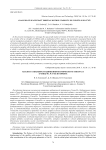
Analysis of spacecraft orbital motion stability of Gonets-M No 37152
Статья научная
In the present investigation we envisage the spacecraft motion of Gonets-M (Gn-M) orbit group which is located in a circular orbit at a height of 1500 km with an inclination of 82.5 degrees. Its movement is measured based on the current navigation parameters which reveal its orbital motion analysis. Gn-M has a special characteristic feature of rotation with apsidal motion in frozen orbit. Based on this fact, the present study was carried out with the conception of a frozen orbit of Gn-M by investigating eccentricity parameter e and perigee argument w. The comparative analysis is presented as graphs which indicates the variation in the values of eccentricity parameters e and the perigee argument w which is calculated based on the current navigation parameters and the predicted motion of Gn-M. An orbital meas- urement was carried out by studying three Gn-M of the same orbital plane over a period of one year. The study insight on the complete analysis of specific changing revolution of the nodical period of Gn-M staying at frozen orbit. The am- plitude vibrations of an orbital nodical period are calculated and compared with the orbital parameters of Gn-M which are in the same orbital plane. Overall the results obtained in the present investigation are promising enough which can aid in improving the calculation accuracy of orbit correction parameters of Gn-M.
Бесплатно
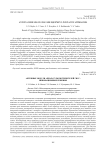
Antenna modules of GNSS user equipment: innovative approaches
Статья научная
An original engineering conception of the navigation antenna module design, involving the idea that a dielectric substrate of the antenna element is made of a ceramic in the form of a turned cup provided with the patch on its top and metalized cavity, in which all active elements are placed, is suggested. The cup-shaped antenna element has additional advantages against the patch antenna of a traditional form: it has a wider matching band, higher radiation efficiency, a wider radiation pattern, and a wider (up to 1.5 times) meridian angle range, with circular field polarization. Metamaterial, used in the antenna element of an all-ceramic type antenna module, allows obtaining a circular field polarization even at low elevation angles, which only a quadrifilar antenna has. To work with all operating GNSS systems (in the extended bandwidth), an antenna element, which has two planar axial elements placed on the common substrate, is proposed. The antenna element can also be designed to work in 2 bands, for example, in L1 and L2 GLONASS/GPS or in L1 and L2 GPS/GALILEO. A multi frequency stacked antenna design method with opposite feeding of the antenna elements, which provides the antenna element isolation of more than 25 dB and identical radiation patterns is suggested. It is proposed to use for multipath mitigating a special type of the EBG-metamaterial and, as well, a special method of multipath mitigating ground plane mounting, which doesn’t narrow antenna element radiation pattern and doesn’t spoil phase center stability.
Бесплатно

Статья научная
The estimation of adequate service life of aircraft instruments is a factor of great importance in aircraft operation process. Changing the instrument service interval affects both reliability (shorter intervals make it easier to locate malfunctions of components and assemblies as early as possible) and economic performance (inducing increase of operating costs). So, the increasing the service interval without potentially reducing reliability is an economically im- portant task. To determine the optimal time to maintenance for aviation components and assemblies, it is necessary to determine the span of their service life with the highest degree of precision. The problem of calculating such estimates is compli- cated by the fact that the data on component failures are scattered and incomplete, which makes it difficult to assess their statistical characteristics accurately. The purpose of this article is to find an effective method of statistical characteristics assessment for small samples as the first stage of modeling of the aircraft components and assemblies reliability. It is induced by specific operational factors of aviation components exchange at small airlines operating Soviet-time aircraft. The article examines two methods of resampling, bootstrap and jackknife. There is also an assessment of mean time to failure expectation for fuel gauges, of the variance and root-mean- square deviation in the article. The bootstrap method is offered as applicable for statistical characteristics assessment of mean time to failure ex- pectation for aircraft components and assemblies taken for analysis in small samples (pressure gauges were chosen as an example of such analysis). The assessments and calculations can be used by airlines to state the nonfailure service time of a variety of components and assemblies.
Бесплатно

Assessment of spacecraft solar array reliability during ground experimental development test
Статья научная
The increase of available power and the lifetime up to 15 years for modern telecommunications satellites significantly actualize the challenge of improving large-sized foldable solar arrays (LF SA) reliability. The reliability of any equipment to be implemented onboard of a spacecraft depends mainly on the quality of their ground experimental test development (GTD). To ensure high quality GTD it is important to accept the correct concept of SA reliability validation, taking into account the specifics of the SA design and the real capabilities of the test facilities. The paper describes constituent parts of the concept allowing validating the large-sized foldable solar arrays reliability at the phase of ground experimental test development. There has been obtained the system of differential equations which describes SA deployment using the off-loading system and, as a result, solving of the differential equations system to estimate errors introduced to the SA elements motion dynamics by the test equipment is given. “Yamal-401” spacecraft SA mechanism reliability has been calculated. The stresses impacting SA mechanism elements during deployment under zero gravity, used during calculation and design of “Yamal-401” spacecraft SA have been defined. The developed methodologies of numerical tests have allowed validating the reliability of all large-scale SA structure elements, under all extreme cases, with regard to the available test facilities. This approach allows performing experimental test development of any large-size SA under development for new generation spacecrafts using existing experimental test facilities and equipment. The results of the research have been used by JSC “Information satellite systems named after academician M. F. Reshetnev” at the phase of ground experimental test of large foldable SA structures for “Express-AM5”, “Yamal-401” spacecrafts and other spacecraft types.
Бесплатно

Automated weight compensation system for ground-based tryout of space vehicle solar panels
Статья научная
In the process of ground-based tryout of solar panels placed aboard the spacecraft there appears the problem of gravity effect compensation. The energy of deployment mechanism is extremely limited, the weight and strength of the structure being calculated for weightlessness conditions. Therefore, under the force of gravity, the power of deployment drives may not be enough to complete the tryout, and the structure itself may be destroyed. Taking into account these difficulties, specialized stands the main part of which is the so-called weight compensation system are designed and created to conduct ground-based pilot tryout. Active weight compensation systems are most effective in this case. In the stands with active weight compensation systems all forces generated by the stand and movements of the stand parts occur through controlled drives. By introducing various sensors into the weight compensation system and by the use of their signals for generation of controlling actions in the control system it becomes possible to significantly increase the level of gravity effect compensation, as well as to minimize the influence of the stand parts inertia. The paper presents the results of the designing, building and testing of the automated active weight compensation system for solar panels. The system provides weight compensation when conducting ground-based experimental tryout of any objects (solar panels, rods, multi-tier spokes, etc.) having a long and transformable in one direction form for distances of the order of 20 m (longitudinal direction). This system also provides movement of the pieces of a tested object in the transverse direction and in height for distances of up to 5 m. The results of departmental tests showed that the weight compensation system with specified parameters described in this paper allows for ground-based tryout of the deployment of solar panels of all constructions, both currently existing and being developed for the future.
Бесплатно

Статья научная
The thermal control system (TCS) is one of the most important systems, which largely determines the design of the spacecraft. At the present stage of development of methods and tools for spacecraft design, a promising direction is the creation of thermal mathematical models of the TCS, calculation algorithms, which allow to create effective design solutions at various design stages. The purpose of this work is to bring the system of equations of heat balances of the liquid circuit (LC) of TCS to a form that allows programmatic numerical integration in the solution search algorithm along the length of the middle line of the heat and mass exchange fluid circuit taking into account certain complex thermal resistances. In fact, this means that the terms of the temperature of the contour and the linear coordinate, the integration variable, should remain as variables in the equation record, everything else should be numerically determined from the properties of the real object. For the boundary conditions of the LC TCS of the spacecraft, the coefficients of complex heat transfer were calculated taking into account the actual topology of the circuit and the thermal properties of the coolant. Using these values, the system of thermal balances of the spacecraft of the spacecraft on the characteristic surfaces of constant temperatures was reduced to a form that allows a numerical solution: the number of equations corresponds to the number of detected temperatures along the north and south panels and is closed through the temperature of the liquid circuit refrigerant. The resulting system of equations allows us to investigate the thermal state of nonhermetic formation spacecraft at the stage of preliminary design with varying operational and design parameters in order to determine the area of efficiency and the area of optimal operation under certain performance criteria.
Бесплатно

Control and regulation equipment of electric power system for a prospective piloted transport system
Статья научная
The aim of this work is to consider solving complex of tasks focused on fulfilling the complicated tactical and tech- nical requirements for regulation and monitoring equipment (RME) of electric power supply system (EPS) for a prospective spacecraft. These requirements are imposed due to the need to ensure high reliability of the equipment during operation under the influence of external factors (vacuum, vibro-impact loads, radiation, absence of convective cool- ing), as well as to achieve high mass-dimensional parameters of the equipment and its high functionality The complexity of problem solving lies in the need to ensure conflicting requirements - high levels of energy density, weight and size characteristics, reliability and durability. These problems fully apply to the RME of the EPS for a prospective piloted transport system (PPTS) which design example shows ways of solving abovementioned problems. The most rational way of solving these contradictions is to increase the specific energy indicators of the main com- ponents of the RME devices - power converters, which can be achieved by using modern power electronic elements, using new materials and semi-finished products, for example, printed circuit boards with a metal heat sink, as well as increasing the layout density design. Determining solution is to select an optimal structure of the power converter, which provides the best efficiency. An additional way to reduce the mass-dimensional indicators of the RME is the use of a digital control method, the collection of telemetric information, and the receiving and processing of commands. At the same time, on the contrary, to ensure the specified reliability of the equipment, it is necessary to use excess reservation at the element level - for power components, and the principles of majority reservation at the functional block level - for control and telemetry schemes. Using the example of RME, developed by CJSC “Orbita”, the main EPS parameters of a new generation spacecraft are shown and most important power supply subsystems are considered in the article: the solar energy control subsys- tem and the power storage subsystem, ways to build them for meeting specified requirements, taking into account the proposed solutions. As a result of this work, the optimal structures of power converters - the current regulator of the solar battery and the current regulator of the battery - were selected, the basic principles of power components reservation ensuring the operability of the equipment in case of a single failure of any component without loss of performance and deterioration of RME parameters as a whole are shown. Block-modular construction method is used for optimal layout and high reliability of the RME, it ensures uniform heat removal from electronic components, which is especially important in vacuum conditions, minimum dimensions and mass optimization of the RME, as well as high mechanical strength of the structure. The implemented principles of building the RME for PPTS using this approach will allow to increase the active lifetime (ALT) and reliability of the spacecraft with a simultaneous decrease in mass and dimension parameters.
Бесплатно

Статья научная
To reduce life time testing period of lithium-ion accumulator (LIA) special dynamic stress test (DST) is widely used. Lithium-ion accumulator dynamic stress test requires automatic charge-discharge devices (CDD) which provides nec- essary DST technological parameters with required precision. Authors developed charge-discharge devices with load converters (CDD-LC), which allow to reproduce required charge-discharge modes of high-power LIA automatically. LIA cyclic charge-discharge with constant power pulses is the most difficult mode of DST. In this case, control sys- tem became nonlinear and time variant due to computation of signal power as multiply of LIA voltage and current. Authors studied mathematical model of electromagnetic processes of CDD-LC in LIA power stabilization mode, formulated requirements to power stabilization control loop quality parameters, synthesized correction devices provid- ing necessary control quality, studied CDD-LC control process absolute stability with Naumov-Tsypkin in LIA power stabilization and regulation modes.
Бесплатно
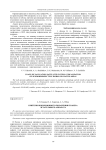
Criteria of airframe corrosive damage
Статья научная
From the analysis of tasks caused by necessity to mitigate and prevent effects of corrosion during scheduled service, the most important one is to define the boundary parameters of corrosion damage.
Бесплатно

Deployment concept mechanical system of a radar antenna for space purposes
Статья научная
One of the basic requirements to deployable mechanical systems is observance of requirements on execution of the first eigenfrequency of structure. In case of transformed structure like solar array, when the structure consists of any panels series connected with joints, this requirement is supplied with high rigidity of a structure. At low rigidity (lower then require) inevitably engenders unnecessary effects on orientation and stabilization system of spacecraft on orbit. Other major aspect of designing of space engineering is decrease in final weight of a product. The most typical line of designing of various systems of space vehicles is compromise search between decrease in weight of a product, and, as consequence, decrease rigidity and strength properties of a structure. In the article the proposed option of a design of a deployable mechanical system. The basic load-bearing element is set of laminate composite panels, connected with joints. The main feature is additional elements (pipe or plate) com- bined with basic panels. The form of a sectional structure is equilateral triangle. Selection of the given type of a structure is proved by two kinds of analyses: the kinematic analysis of a deployment from a shipping rule in working, and the modal analysis for reliability acknowledgement on first eigenfrequency. The parametric analysis of geometry of a design is carried out, optimum versions are shown. For deeper optimization of design parameters it is necessary to carry out the following engineering analyses which have been not presented within the limits of the given article: the analysis of reliability of a deployment of mechanical devices; the structural analysis; the analysis of temperature deformations and so forth. The given design can be applied as the power basis to solar array, antennas, and cluster orbital systems.
Бесплатно

Статья научная
Construction of communication spacecraft with large-size transformable antennas developed tendencies to increase the operational band frequencies, to reduce specific mass and to increase the overall dimensions of the structures. The improvement of technical performance of communication spacecraft with large-size antennas cannot be achieved with- out ensuring the required accuracy of antenna pattern and of the antenna gain coefficient at its maximum. Factors affecting the final quality of large-size structures for space application (of antennas in particular), keep influencing the products through all their service life - from design and production to tests and actual operation. The “direct” elimination of the negative factors affecting the final output is often unprofitable considering the present de- velopment of technological support in hi-tech industries. In this respect, control of the ultimate operational characteris- tics of large-size spacecraft antennas in conditions of real performance, and compensation, if necessary, of deviations from the required values, is optimal with respect to the output/cost ratio. This approach is practical in determining the onboard antenna pattern and compensating its operational distortions in the process of specified spacecraft performance. There are two methods of measuring the antenna pattern at the orbit. The first method is based on measurements of radio engineering characteristics obtained from ground space vehicles’ service stations. This method is sufficiently accurate, but it has several drawbacks. For example, this method increases the number of requirements to ground stations - their number, location and characteristics of the equipment in use. The second method bases on obtaining radio engi- neering characteristics from the configuration and orientation of antenna reflector. The reflector is imaged as a cloud of checkpoints reflecting the deviations of the construction’s configuration and orientation from the specified values. To obtain the antenna pattern measurements using the second method, an antenna configuration control system (ACCS) must be worked out for measuring the coordinates of the reflector surface points. To perform its specific func- tion, the system should have the following configuration: measuring equipment mounted on the spacecraft casing, and control elements fixed on the construction components. This configuration allows to present the antenna construction components in the form of checkpoint cloud. In the process of the system development the constructional analysis of the possibility of using the antenna configu- ration measurements for the its pattern calculation and for further assessment of its deviation from the specified values was made. This article presents the assessment of the required number of monitored checkpoints on the reflector sur- face. For this purpose, Ku-band of frequencies was chosen as one of the most common frequency bands used by telecommunication spacecraft. Several sets of points were considered, among them the sets belonging both to the deformed reflector profile and to the one without deformation. For each set the antenna pattern calculation was made. Visual representations of the focal beam and the directive antenna gain were compared. The analysis of the obtained data allowed to determine the necessary minimum of checkpoints for antenna pattern calculation with the required accuracy. The obtained data were taken into account in formulating the requirements for the system of orbital control of antenna configuration.
Бесплатно

Determination of total ionization dose by ray trace analysis based on a geodesic sphere
Статья научная
When designing the spacecraft, it is necessary to take into account the deleterious action of various factors in outer space. The main factor limiting active life of spacecraft is ionization radiation and it is the cause of most failures. Its influence is accompanied by ionization losses of the energy of charged particles in active and passive areas of semi- conductors and integrated circuits; that leads to emergence of radiation effects and it is characterized by the value of absorbed dose. At present there are several approaches to forecast the value of total ionization dose (TID): Monte- Carlo methods, methods that take into account only standard shield geometry (sphere, plane) and ray trace analysis (or sector-based analysis). The paper presents a modification of ray trace analysis that uses a geodesic sphere for sector construction and pro- vides regularly distribution of tracing rays in space unlike classical approach with using a parametrical representation of a sphere. Our approach enables to take into consideration real density of materials and allows using fewer sectors to meet the requirements of the method 154.PM-129 and keeping calculation accuracy. This is especially important for carrying out element-by-element radiation analysis taking into account heterogeneous protection through shielding of calculated point by elements of spacecraft design. This method is implemented as an extension for SolidWorks CAD. The input data for calculation are the following: 3d-model of equipment component as a part of spacecraft and radiation attenuation tables. The accuracy and the speed of the analysis depends on the number of tracing rays, and it is possible to carry out the calculation for several types of ionizing radiation at the same time. As an example of using the proposed method and a software module, we carried out radiation analysis of the block of the on-board digital computer for the spacecraft “Sfera”; its active life duration is 10 years on a high-elliptic orbit and 15 years on a geostationary orbit. As a result, we revealed that for the elements of the block minimum and maxi- mum total ionization doses differed substantially. It means that taking into account shielding properties of structural elements of device and blocks makes significant contribution to TID calculation.
Бесплатно

Статья научная
The main function of a thermal control system (TCS) is to maintain the temperature at nodal points of a spacecraft in given ranges due to redistribution of thermal energy and the discharge of excess thermal energy into space. TCS may have a different design and principle of operation. One of the most common options is TCS using a liquid circuit (LC) and pumping coolant circulation. In the development of promising design-layout schemes for instrument compartments of nonhermetic formation spacecraft, it becomes necessary to state and solve new problems associated with the creation of computational and mathematical models of intermediate convective heat transfer in a fluid circuit. For systems of integral equations of a LC thermal model with fairly complex topographic boundaries and connections, the justification and use of the defining (equivalent) thermal resistance seems to be a compromise of counting implementation of a system that simulates a TCS with integration along the length of the LC. In this paper, for the computational model of the liquid circuit of the thermal control system, including the system of equations of two-dimensional thermal balance of the characteristic surfaces of a nonhermetic formation spacecraft, a method of calculating the determining thermal resistances was proposed and implemented. This method includes the calculation of the complex heat transfer coefficient and the local heat transfer coefficient to the heat carrier flow. The approach considered in this paper allows us to obtain a numerical solution for the distribution of heat flows and temperatures of liquid circuits with complex topographic boundaries and connections with minimal loss of accuracy. The determination of the local heat transfer coefficient makes it possible to take into account the influence of changes in the temperature of the coolant flow on the overall picture of convective heat exchange.
Бесплатно
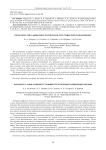
Developing the laboratory test bench of fuel three-point measurement
Статья научная
The development of digital technology allows continuous improvements in many areas. This paper reflects the development of a new fuel measurement method. To measure the fuel, the authors propose three fuel sensors and a computational element to simulate the position of the fuel level in space with further calculating the volume of fuel, to reduce errors due to the fuel meters operation. The main advantage of this system is the elimination of errors arising from the evolution of an aircraft, as well as its uneven movement. The paper demonstrates a phased development of a laboratory test bench to study the three-point method to measure fuel. In the course of the work, a vessel is assembled to simulate the fuel tank of the aircraft. The vessel is a glass container with submersible measuring sensors. Also, the research contains calculation of the bridge electrical circuit to compute a voltage value at each sensor. In the test, transformer fluid substitutes fuel, since it acted as a dielectric. The program code for the microcontroller is recorded. The proposed method has several advantages in comparison with traditional methods of measuring the fuel level; a mathematical model is presented, on the basis of which the level of fuel in the aircraft fuel tank is measured.
Бесплатно

Development of interface module emulator architecture for spacecraft life support systems
Статья научная
The article gives an analysis of special characteristics of ground-based experimental evaluation of on-board radioelectronic equipment, taking the control unit of up-to date spacecraft on-board control complex as the test objective. The focus is the problem of providing testing procedures of the specific software employed in design and manufacture process. A solution of the problem is worked out on the basis of performance of a hardware-software complex which emulates interface modules for the computing module of control unit. According to the general operation algorithm of the control unit, the developed complex is regarded as a multi-user system. The main functional requirements for hardware-software emulator, regarded as the corresponding queuing system, are also defined. The results of the experiments with the computer module operation prompted the requirements for the emulator response time from the point of view of its operation stability in real strict-time mode. In order to ensure the required efficiency of operation, the emulated functions of the interface modules are classified according to the severity level of their execution determinacy. The results of experimental evaluation оf the service channel hardware design variants when applying multi-functional reconfigurable input-output digital devices allowed to develop a hardware-software emulator structural circuit based on operation parallelism of programmable integrated logic circuits and flexibility of software reconfiguration. The realization of emulated functions of selected classes within the available architecture was carried out using the corresponding hardware blocks and software module. The presented analysis of the emulator response limits was performed with the application of National Instruments technologies. The results of the developed hardwaresoftware emulator evaluation and practical application, as well as other possible ways of applying the proposed approach for tests of spacecraft on-board radio-electronic equipment and space system components were also analyzed.
Бесплатно

Статья научная
The control system of a launch vehicle (LV) at the initial phase of flight at altitudes between 0 and 300 meters is the object of investigation in the article. At this phase the flame of the LV jet engine is the cause of a negative impact on facilities of the launch complex. This effect can be reduced by displacing the jet flame in a certain radial direction with increased resistance of the facilities using a specially developed vehicle motion control program. The purpose of the article is to develop an algorithm for the controller of the LV motion control system on the considered “displacement phase” of the trajectory that provides an implementation of such a program. To solve the problem, we developed the modified version of the Letov’s method of analytical construction of regula- tors (ACOR). The peculiarity of the modified statement of the problem solved in the work is that the controlled output vector of the system depends explicitly not only on the LV state vector, but also on the control variable. The quality of control is evaluated using a quadratic terminal-integral optimality criterion. This kind of criterion allows to trace with the specified accuracy the preliminary calculated program for supporting the required position of the trace of the LV jet flame on the launching plane, and also to ensure the vertical position and the zero angular velocity of the vehicle at the end of the displacement phase. To solve the problem of constructing the algorithm, a special linearized model of the LV motion has been developed. The results of simulating the controlled motion of a launch vehicle with the use of the algorithm confirm the operability and demonstrate efficiency of the developed optimal regulator of the LV control system at the displacement phase under consideration. Calculation results show that angular position of the LV at the end of the displacement phase is close to vertical, the angle of the engine nozzle deflection is within the permissible limits and the deviation of the current position of the jet flame track from the program value does not exceed 0.5 meters.
Бесплатно
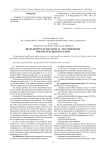
Development of mechanical test procedure for the fuel bellows tanks
Статья научная
The mechanical qualification and acceptance test requirements are considered for the fuel bellows tanks. Some procedural mistakes taking place during these tests are described.
Бесплатно

Статья научная
The article provides a brief description of the flight scheme of a prospective automatic spacecraft intended for the study of Mars and its satellites by remote and contact methods. At the near-Martian expedition site, it is planned to first bring the vehicle into orbit of the artificial satellite Deimos, and then landing on Phobos with the subsequent delivery of its soil to Earth. The main ballistic characteristics of the spacecraft flight conditions at all stages of the flight at launch after 2025 are given. The time frames for the five starting periods are considered - in 2026, 2028, 2030, 2033 and 2035. The launch of the spacecraft on the flight path to Mars is performed by a heavy class launcher. The article describes the design of the vehicle, propulsion systems of its modules and flight scheme at all stages - from launch from the Earth to landing on Phobos, and returning back to Earth. The article describes the propulsion systems of the main spacecraft units proposed for the mission implementation - the propulsion module, the flight landing platform and the return vehicle. The designs of these units are provided in the work. Flight schemes have been developed in accordance with their characteristics, which allows conducting remote study of Deimos, making a soft landing on the surface of Phobos, and then delivering samples of its soil to Earth. The project should be developed on the basis of the spacecraft launch from the Vostochny launch site by the Angara-A5 launch vehicle and the KVTK upper stage. An alternative variant of the construction of a spacecraft involves the use of a vehicle of a lighter class - perspective Soyuz-5 launch vehicle and Fregat-SBU upper stage. In this case, the engine module is excluded, and the flight and landing module is replaced by a heavier version with larger tanks. Both proposed options for constructing a spacecraft make it possible to implement the developed trajectory, while ensuring full-time operation of the target equipment and conducting a set of experiments during a given period of active spacecraft existence.
Бесплатно

